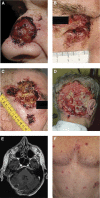Challenges and new horizons in the management of advanced basal cell carcinoma: a UK perspective
- PMID: 25211660
- PMCID: PMC4200081
- DOI: 10.1038/bjc.2014.270
Challenges and new horizons in the management of advanced basal cell carcinoma: a UK perspective
Abstract
Basal cell carcinoma (BCC) is a common malignancy with a good prognosis in the majority of cases. However, some BCC patients develop a more advanced disease that poses significant management challenges. Such cases include locally advanced, recurrent or metastatic BCC, or tumours that occur in anatomical sites where surgical treatment would result in significant deformity. Until recently, treatment options for these patients have been limited, but increased understanding of the molecular basis of BCC has enabled potential therapies, such as hedgehog signalling pathway inhibitors, to be developed. A clear definition of advanced BCC as a distinct disease entity and formal management guidelines have not previously been published, presumably because of the rarity, heterogeneity and lack of treatment options available for the disease. Here we provide a UK perspective from a multidisciplinary group of experts involved in the treatment of complex cases of BCC, addressing the key challenges associated with the perceived definition and management of the disease. With new treatments on the horizon, we further propose a definition for advanced BCC that may be used as a guide for healthcare professionals involved in disease diagnosis and management.
Figures


References
-
- Artis AHMM, Mosterd K, Essers BAB, Spoorenberg E, Sommer A, De Rooij MJM, van Pelt HPA, Quaedvlieg PJF, Krekels GAM, van Neer PAFA, Rijzewijk JJ, van Geest AJ, Steijlen PM, Nelemans PJ, Kelleners-Smeets NWJ. Photodynamic therapy versus topical imiquimod versus topical fluorouracil for treatment of superficial basal-cell carcinoma: a single blind, non-inferiority, randomised controlled trial. Lancet Oncol. 2013;14:647–654. - PubMed
-
- Baxter JM, Patel AN, Varma S. Facial basal cell carcinoma. Br Med J. 2012;345:e5342. - PubMed
-
- Castori M, Morrone A, Kanitakis J, Grammatico P. Genetic skin diseases predisposing to basal cell carcinoma. Eur J Dermatol. 2012;22:299–309. - PubMed
-
- Chakravarty EF, Michaud K, Wolfe F. Skin cancer, rheumatoid arthritis, and tumor necrosis factor inhibitors. J Rheumatol. 2005;32:2130–2135. - PubMed
Publication types
MeSH terms
Grants and funding
LinkOut - more resources
Full Text Sources
Other Literature Sources
Medical

